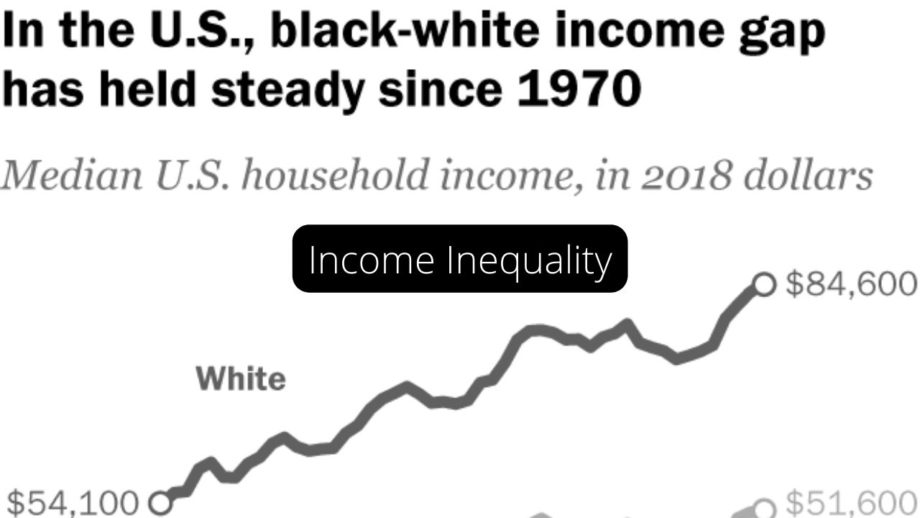Income Inequality: The Wealth Gap Built by Design
Why Is the Racial Wealth Gap So Persistent?
Income inequality in America isn’t random — it’s the result of centuries of policy, theft, and exclusion. For Black Americans especially, income inequality means being systematically denied the opportunities and generational wealth-building that white Americans have historically accessed. Despite decades of civil rights legislation, the income and wealth gap between Black and white households has barely budged since 1970. And that’s no coincidence — it’s by design.
The racial income and wealth gap in the United States isn’t new. It’s not accidental. And it hasn’t improved in decades.
In fact, data from the ACLU reported that the Pew Research Center showed that since 1970, the Black–white income gap has barely changed. In 2018 dollars, the typical white household earned nearly $84,600 a year, while the typical Black household earned just $51,600.
That’s not just a gap. That’s a system. And it didn’t start with laziness or spending habits. It started with slavery.
How Did We Get Here?
For hundreds of years, white Americans were allowed to build and inherit wealth. Black Americans were denied that opportunity at nearly every stage.
It began with stolen labor under slavery, where entire generations worked without pay. After emancipation, systems like sharecropping ensured that Black families remained stuck in cycles of debt and dependency. Then came redlining, where banks refused to offer home loans to Black buyers, even if they qualified. That policy alone locked Black families out of the largest wealth-building opportunity in American history — homeownership in the suburbs.
Layered on top were discrimination in hiring, implicit bias in wages, and racially unequal access to education. Even today, studies show that Black workers are paid less than white workers with the same credentials — and are less likely to be hired in the first place.
Then came the War on Drugs, mass incarceration, and sentencing disparity, which removed hundreds of thousands of Black men and women from the workforce entirely.
This wasn’t just economic neglect. It was deliberate wealth suppression.
What Are the Real-Life Effects if Income Inequality?
Income inequality impacts every part of life:
- Health outcomes are worse for Black families with lower income and limited access to care
- School segregation and underfunding follow economic lines, keeping opportunity unequal
- Home values and equity accumulation remain stunted by the legacy of racial steering
- Black women, who are often heads of household, face a triple wage penalty for race, gender, and motherhood
This is why wealth gaps still exist even when education is equal. It’s not about effort. It’s about how the starting line is miles apart.
It’s Still Happening Today
Even now, headlines repeat the same pattern:
- “Blacks and Latinos Will Be Broke in a Few Decades” (Forbes)
- “Whites Have Huge Wealth Edge Over Blacks (But Don’t Know It)” (NYTimes)
- “The Wage Gap Between Black and White Workers Is Growing” (Money)
Yet the systems causing these gaps often go unchallenged. Politicians talk about closing the gap, but rarely fund the solutions. Banks sponsor DEI panels while still redlining communities through modern practices like credit scoring algorithms and property appraisals that undervalue Black homes.
And when people fight back — whether through policy, protest, or education — they’re often told to “work harder” or “pull themselves up by the bootstraps.”
But how do you pull yourself up when you were never given boots?
Wikipedia
Racial wage gap in the United States | Black
Causes of income inequality in the United States | Race and gender disparities
Wealth inequality in the United States | Racial disparities
Video
Blacks and Latinos Will Be Broke in a Few Decades (Fortune)
The Racial Wealth Gap in America (Urban Institute)
Further Reading
50 years after the riots: Continued economic inequality for African Americans (Economic Policy Institute)
Systematic Inequality How America’s Structural Racism Helped Create the Black-White Wealth Gap (Center for American Progress)
Whites Have Huge Wealth Edge Over Blacks (but Don’t Know It) (New York Times)
The Wage Gap Between Black and White Workers Is Growing (Money)
The wage gap between blacks and whites is the largest since 1979 (Business Insider)
U.S. Income Inequality Hits a Disturbing New Threshold (Bloomberg)
The Income Gap Between Blacks And Whites Has Only Gotten Worse Since The 1960s (Bloomberg)
Visualizing the Racial Wealth Gap (ACLU)
We Were Never the Problem
Income inequality was never about individual choices. It was about national policies. It was about generational theft. It was about a country that built its economy on the backs of Black people, then locked them out of its rewards.
🖤 “We Were Never The Problem” is a refusal to carry that blame. It’s a statement of truth for every family denied land, loans, or labor rights. It’s for every parent who worked twice as hard to be paid half as much. And it’s for every child still climbing out of a hole they didn’t dig.
👉 Wear the message. Start the conversation. Shop the shirt.
*cover image from Pew Research Center
